MusicRadar Verdict
A flexible synth, to be sure, but be prepared to take some time to discover all that Blue has to offer.
Pros
- +
Lots of synthesis types and options. Great range of sounds. Intuitive interface. Rob Papen!
Cons
- -
Can be a CPU hog. You need to dig deep to realise its full potential.
MusicRadar's got your back
The people behind Blue clearly believe that putting its producer's name on the box will help shift a few more units - this isn't just a virtual instrument, it's a Rob Papen virtual instrument.
It only really works if you know who on earth Papen is, but, as he was responsible for the mighty Albino synth, maybe he's got the right to crow a little bit. Installing Papen's latest creation doesn't present any problems. There's no challenge/response system here - all you need to do is type in a code and you're away.
Overview
On paper, Blue is a beast of a thing. Indeed, it comes packed with seemingly everything you could ever want in a synth.
There are six oscillators and three synthesis types (analogue, additive and spectral), a couple of multimode filters, nine envelopes, four multi-envelopes, three modulation sequencers, one step sequencer, two effects… and a partridge in a pear tree.
Blue certainly looks impressive at first glance, then, but are its multitude of features going to stretch your computer beyond breaking point?
Some users have already reported that Blue is a CPU hog, with one forum member claiming that the playing of a chord pushed his levels up to 84% on a P4 2GHz.
Well, we tried it on an old PIII 1GHz in Cubase and never got beyond about 70%, even with five notes of polyphony played on the lushest of pads and sequences.
Generally, it came in at around 40%. It's fair to say that Blue is more demanding than Albino - two or three times more, in fact. It did run more efficiently in Live on our iMac G5, where we got levels of 10-50% for our five notes of polyphony.
So, the message is that although Blue can be a hog, it very much depends on your system. Our experiments certainly raised more questions about Mac vs PC and Cubase vs Live than ever before, but let's not go there just now…
Multiple synthesis engines
Because of all its synthesis types, Blue is being sold as a 'cross-fusion' synth. All of these synthesis engines can be combined, so in theory it's possible to create pretty much any type of sound you like.
However, as Blue is being sold on the strength of Papen's sound design skills, let's run through the presets…
Blue has so many different sounds that it can be difficult to get your head around what it's good at. The waveform sequences initially stand out - probably because there are so many of them - but there are also some quite wonderful bass sounds.
These demonstrate the synth's 'analogue' capabilities - the lush strings and metallic pads, on the other hand, show off its FM side.
All of this means that Blue is quite a hard synth to sell and market. Because it does so much, you might feel that it lacks any particular strengths or character. (Maybe that's why they simply decided to put Papen's name on it - as an all-encompassing mark of quality.)
Though they're by no means poor, it could be argued that the presets don't quite make the most of the massive engine that sits behind them.
These are good sounds - some of them are excellent - but there's little here that you won't have heard before in the likes of Z3TA+, FM7 and Papen's own Albino.
The synth only comes into its own when you immerse yourself in it, and this is where Jon Ayres (Papen's partner on the Blue project) comes in. Ayres has designed Blue so that you can easily get your head around the myriad creative possibilities that it offers.
The six oscillators take pride of place, and underneath them are the two filters. It's Blue's LCD-type screen that's most noteworthy, though: each of the buttons above it reveals a single page of options, so it's easy to access all of Blue's functions and, more importantly, adjust them graphically.
It's a great system - one that enables you to see exactly how a sound 'works' - and ultimately, it makes programming Blue a lot easier than it should be when you consider its specifications.
So who is Blue aimed at? Well, given that it contains all of those different synthesis types and easy-to-use functions, it could be seen as something of a 'best of' synth.
However, although you can generate all of the sounds that are associated with its numerous synthesis options, Blue does perhaps lack the personality of some of its more specialist cousins.
If you're looking for a 'do everything' workhorse, this is a fairly decent option, but if you want to unlock Blue's true potential, you'll need to travel a long way beyond the presets and explore it in much more depth.
Computer Music magazine is the world’s best selling publication dedicated solely to making great music with your Mac or PC computer. Each issue it brings its lucky readers the best in cutting-edge tutorials, need-to-know, expert software reviews and even all the tools you actually need to make great music today, courtesy of our legendary CM Plugin Suite.
“The most musical, unique and dynamic distortion effects I’ve ever used”: Linkin Park reveal the secret weapon behind their From Zero guitar tone – and it was designed by former Poison guitarist Blues Saraceno’s dad
Arturia’s V Collection gets a Roland JP-8000 emulation and lo-fi synth/sampler, along with five more instruments and a host of updates
Capture the sound of The Last of Us season 2's haunting soundtrack with Spitfire Audio’s latest software instrument, Ronroco by Gustavo Santaolalla











